calsfoundation@cals.org
Pauline Pfeiffer (1895–1951)
Pauline Pfeiffer was a successful journalist who wrote for such magazines as Vanity Fair and Vogue. From 1927 to 1940, she was married to author Ernest Hemingway, being the second of his four wives. At her family’s home in Piggott (Clay County), Hemingway wrote some of the works that would contribute to a 1954 Nobel Laureate in Literature for his contribution to writing. Hemingway credited her as being the best editor with whom he ever worked.
Pauline Marie Pfeiffer was born in Parkersburg, Iowa, on July 22, 1895, to Mary Downey Pfeiffer and wealthy businessman Paul Pfeiffer. Pauline was the oldest of the Pfeiffers’ four children; Karl was born in 1900, Virginia (called Jinny) in 1902, and Max in 1907 (he died in the 1918 flu epidemic). When she was six years old, the family moved to a comfortable home in St. Louis, Missouri, where her father joined his family’s chemical company.
Pfeiffer graduated from the St. Louis Academy of the Visitation in 1913, winning the school’s prize for English. She entered the University of Missouri in Columbia and graduated in 1918 from its School of Journalism, the first such school in the nation.
While she was away at college, her family moved to Piggott. Paul Pfeiffer bought thousands of acres of land, overseeing tenant farmers and later going into the lumber business. Paul and Mary Pfeiffer were community leaders in Piggott, living in a spacious home. Pauline Pfeiffer visited frequently, though after graduating from college, she set out on her own, starting in Ohio at the Cleveland Press, where she worked as a copyeditor. She relocated to Manhattan to become a reporter for the New York Morning Telegraph but soon moved to the glossy magazines Vanity Fair and Vogue.
On assignment for Vogue, Pfeiffer went to Paris, France, in early 1925, accompanied by her sister, Jinny. Within a month, they met up-and-coming writer Ernest Hemingway and his first wife, Hadley. The group became friends, even vacationing together. Soon, an affair between Ernest Hemingway and Pauline Pfeiffer became known to the Paris arts community, including Hemingway’s wife.
Hadley and Ernest Hemingway divorced in early 1927. Part of the agreement was that Hemingway and Pfeiffer would separate for 100 days to confirm that their affair was not a passing fancy. Pauline returned to the Pfeiffer home in Arkansas, during which time Hemingway sent her his manuscripts for editing.
In May 1927, Pfeiffer married Hemingway in Paris. She asked Hemingway to convert to Catholicism before the marriage, which he did.
The couple left Paris in March 1928. Pauline was expecting their first child and wished to return to the United States. They arrived in Piggott, where Hemingway often spent time hunting quail along with working regularly on his writing. A small barn at the Pfeiffer home was converted into his private writing studio, where he worked on the novel A Farewell to Arms.
Pauline gave birth to Patrick Hemingway in Kansas City, Missouri, on June 1928 after having a difficult labor. During this time, Hemingway was writing about his character Catherine Barkley having a difficult delivery and dying in childbirth.
The Hemingways spent most of their time in Key West, Florida, by the early 1930s. A second son, Gregory, was born in Kansas City in November 1931. During the winter of 1932, Hemingway joined his wife in Piggott for a holiday visit to the family home with their children. The Hemingway short story “A Day’s Wait,” concerning the illness of a small boy, was written about this visit. It was published in a 1933 short-story collection, Winner Take Nothing, which was Hemingway’s third and final collection of stories.
During Pfeiffer’s marriage to Hemingway, several of his major works were published, including A Farewell to Arms in 1929, Death in the Afternoon in 1932, and 1935’s Green Hills of Africa, an account of a 1933 safari with Pauline. The couple also acquired two of the most iconic purchases in Hemingway lore, the yacht Pilar and a home in Key West.
In 1936, Hemingway met glamorous journalist Martha Gellhorn at a bar in Key West. His marriage to Pfeiffer was in conflict, partly due to each favoring opposite sides in the Spanish Civil War (1936–1939). Hemingway and Gellhorn departed to Spain to cover the war, afterward living together in Cuba while Pfeiffer remained in Key West.
Because of her Catholic beliefs, she resisted divorce, but Hemingway ultimately granted her one in 1940, three weeks before to his marriage to Gellhorn. She spent the rest of her life in Key West. However, she often visited Jinny in California, where she died at age fifty-six on October 1, 1951, reportedly from a brain hemorrhage. She was buried in Hollywood Memorial Cemetery.
The Pfeiffer house and barn in Piggott were placed on the National Register of Historic Places in 1982 and constitute the Hemingway-Pfeiffer Museum and Educational Center.
For additional information:
Hawkins, Ruth. Unbelievable Happiness and Final Sorrow: The Hemingway-Pfeiffer Marriage. Fayetteville: University of Arkansas Press, 2012.
Hemingway-Pfeiffer Museum and Educational Center. http://hemingway.astate.edu (accessed February 5, 2020).
Hotchner, A. E. Hemingway in Love: His Own Story. New York: St. Martin’s Press, 2015.
Nancy Hendricks
Garland County Historical Society
 Early Twentieth Century, 1901 through 1940
Early Twentieth Century, 1901 through 1940 Mass Media
Mass Media Women
Women Hemingway-Pfeiffer Museum
Hemingway-Pfeiffer Museum  Pauline Pfeiffer
Pauline Pfeiffer 




Comments
No comments on this entry yet.